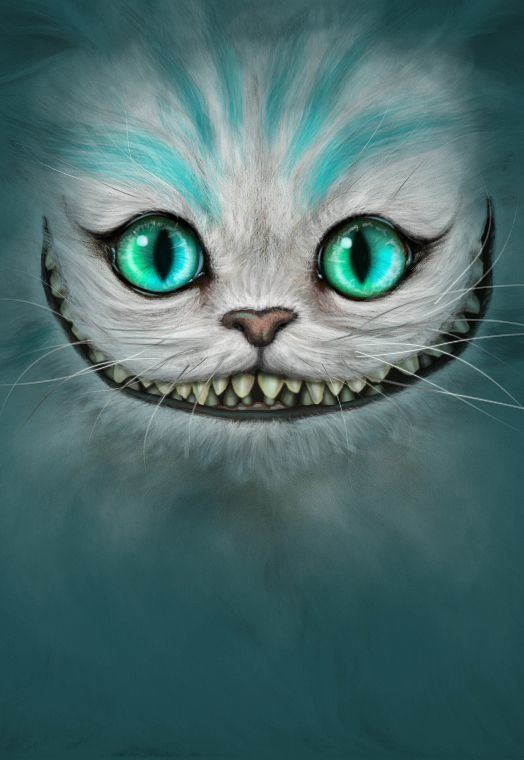 | ||
Voiced by Sterling HollowayTony Pope (Disneyland attractions)Jim Cummings (current)Keith David (Once Upon A Time in Wonderland)Stephen Fry Quote "Most everyone's mad here""You may have noticed that I'm not all there myself" Personality Comical, Silly, Mysterious, Insane, Sneaky, Cunning, Mischievous, Unpredictable Appearance Pink stripes, Obese purple cat, Yellow eyeballs, Large grin, Long fluffy tail, Small black claws, Small ears Likes Giving Alice some very good advice, Standing on his head, Showcasing his abilities, Tricking people (especially Alice) Dislikes Seeing Alice upset (unless he 'playfully' caused it) Similar The Mad Hatter, Alice, White Rabbit, Queen of Hearts, Caterpillar | ||
Alice in wonderland cheshire cat
The Cheshire Cat (/ˈtʃɛʃər/ or /ˈtʃɛʃɪər/) is a fictional cat popularised by Lewis Carroll in Alice's Adventures in Wonderland and known for its distinctive mischievous grin. While most often celebrated in Alice-related contexts, the Cheshire Cat predates the 1865 novel and has transcended the context of literature and become enmeshed in popular culture, appearing in various forms of media, from political cartoons to television, as well as cross-disciplinary studies, from business to science. One of its distinguishing features is that from time to time its body disappears, the last thing visible being its iconic grin.
Contents
- Alice in wonderland cheshire cat
- Alice in wonderland the cheshire cat
- Origins
- Lewis Carrolls character
- Source of imagery
- Novels
- American comics
- Anime and manga
- Art
- References
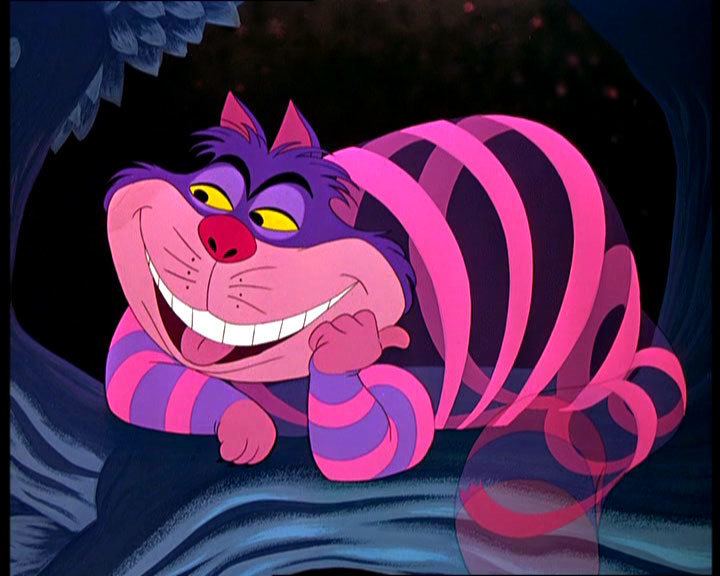
Alice in wonderland the cheshire cat
Origins
There are numerous theories about the origins of the phrase "Grinning like a Cheshire Cat" in English history.
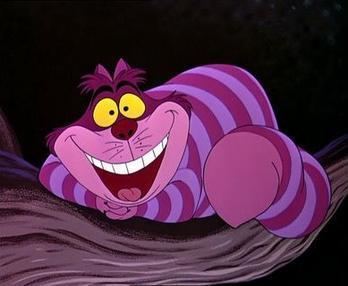
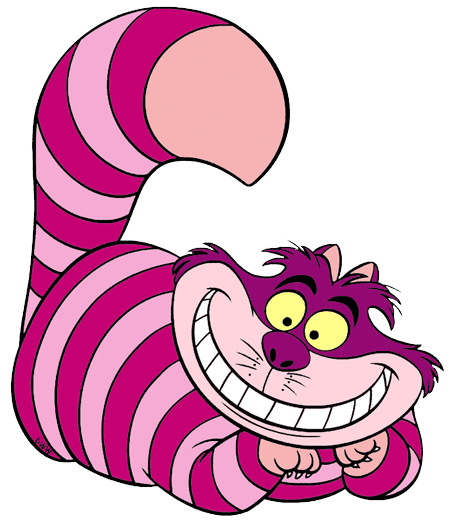
This phrase owes its origin to the unhappy attempts of a sign painter of that country to represent a lion rampant, which was the crest of an influential family, on the sign-boards of many of the inns. The resemblance of these lions to cats caused them to be generally called by the more ignoble name. A similar case is to be found in the village of Charlton, between Pewsey and Devizes, Wiltshire. A public-house by the roadside is commonly known by the name of The Cat at Charlton. The sign of the house was originally a lion or tiger, or some such animal, the crest of the family of Sir Edward Poore.
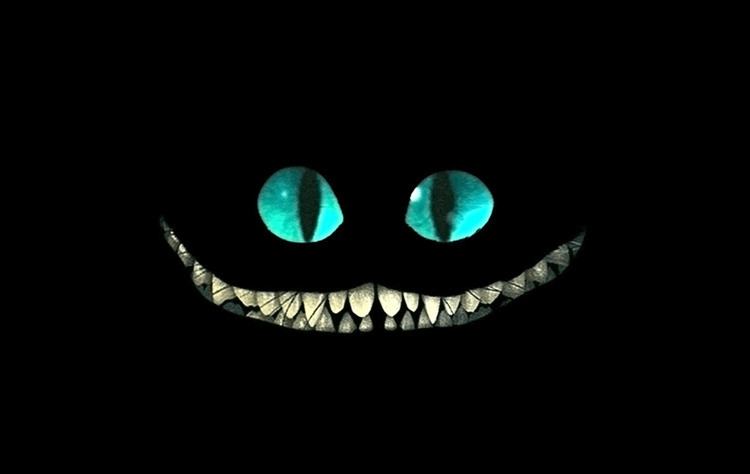
Lewis Carroll's character
The Cheshire Cat is now largely identified with the character of the same name in Lewis Carroll's novel Alice's Adventures in Wonderland. Alice first encounters the Cheshire Cat at the Duchess' house in her kitchen, and later on the branches of a tree, where it appears and disappears at will, and engages Alice in amusing but sometimes perplexing conversation. The cat sometimes raises philosophical points that annoy or baffle Alice; but appears to cheer her when it appears suddenly at the Queen of Hearts' croquet field; and when sentenced to death, baffles everyone by having made its head appear without its body, sparking a debate between the executioner and the King and Queen of Hearts about whether a disembodied head can indeed be beheaded. At one point, the cat disappears gradually until nothing is left but its grin, prompting Alice to remark that 'she has often seen a cat without a grin but never a grin without a cat'.
According to recent analysis by scholar David Day, Lewis Carroll's cat was Reverend Dr Edward Bouverie Pusey, Oxford professor of Hebrew, and Carroll's mentor.
The name Pusey was suggested by Alice's deferential address of the cat as "Cheshire Puss". Pusey was an authority on the fathers of the Christian Church, and in Carroll's time Pusey was known as the Patristic Catenary (or chain), after the chain of authority of Church patriarchs. As a mathematician, Carroll would have been well familiar with the other meaning of catenary: the curve of a horizontally-suspended chain, which suggests the shape of the cat's grin.
RIDDLE: What kind of a cat can grin? ANSWER: A Catenary.
Source of imagery
There are many other suggestions that Carroll found inspiration for the name and expression of the Cheshire Cat in the 16th century sandstone carving of a grinning cat, on the west face of St. Wilfrid's Church tower in Grappenhall, a village adjacent to his birthplace in Daresbury, Cheshire.
Lewis Carroll's father, Reverend Charles Dodgson, was Rector of Croft and Archdeacon of Richmond in North Yorkshire, England, from 1843 to 1868; Carroll lived here from 1843 to 1850. Historians believe Lewis Carroll's Cheshire Cat in the book Alice in Wonderland was inspired by a carving in Croft church.
Another possible inspiration was the British Shorthair: Carroll saw a representative British Shorthair illustrated on a label of Cheshire cheese. The Cat Fanciers' Association profile reads: "When gracelessness is observed, the British Shorthair is duly embarrassed, quickly recovering with a 'Cheshire cat smile'”.
In 1992, members of the Lewis Carroll Society attributed it to a gargoyle found on a pillar in St. Nicolas Church, Cranleigh, where Carroll used to travel frequently when he lived in Guildford (though this is doubtful as he moved to Guildford some three years after Alice's Adventures in Wonderland had been published) and a carving in a church in the village of Croft-on-Tees, in the north east of England, where his father had been rector.
Carroll is believed to have visited St. Christopher's church in Pott Shrigley, Cheshire, which has a stone sculpture most closely resembling the pictorial cat in the book.
Novels
The Cheshire cat has inspired other characters in the publishing world:
American comics
The Cheshire Cat can be spotted in several comics by major American publishers:
Anime and manga
The Cheshire Cat character has been embraced by the world of Japanese comics (Manga) and animation (Anime), where several odes to the Cheshire Cat have been observed:
Art
The Cheshire Cat has transcended screens to be featured in fine art:
